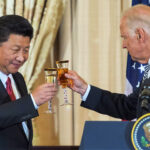Months after the controversy surrounding a Chinese spy balloon that was allowed to drift across the U.S. uninterrupted, a new report out Thursday morning is changing the narrative a bit on what the balloon was doing and how it was constructed.
Unnamed U.S. officials have told ABC News that the balloon, which was shot down in February after it had safely reached the Atlantic, was constructed using American-made parts, signaling concerns about black market trade of U.S. chips – which are barred from being sold in certain markets, like China.
Officials also told the news organization that the balloon did not transmit data, as previously believed.
The Chinese spy balloon that was shot down over the Atlantic Ocean in early February was built — at least partly — using American off-the-shelf parts, a U.S. official has confirmed to ABC News.
A second U.S. official was also able to confirm that the balloon did not appear to have transmitted any of the data it collected on its journey above North America, as was initially reported by the Wall Street Journal.
The first official could not say whether any of the American gear was sold illicitly to China but said determining whether any of it came from illegal trade was a topic of serious concern among officials since some items — like chips — are forbidden to sell to certain markets.
The original revelation that the balloon was transmitting data back to the Chinese were a black eye on the Biden administration, which had maintained the balloon was harmless. But it was almost certainly collecting that data as it drifted across the country unfettered.
What it intended to do with that data is unclear, however. It was first made public when it was observed near a military installation, and there were calls to have it shot down immediately. The Biden administration, however, refused to act, claiming it could cause injury to civilians below. That ultimately led to a days-long journey across the rest of the U.S., when it was finally shot down over the Atlantic coast.
Since then, revelations about the Biden administration’s response have shed a light on how they wish to deal with China. Leaked emails showed that some in the administration were seemingly trying to protect China as a means of maintaining a stable relationship with them.
In other words, instead of punishing China for its insanely provocative violation of US airspace and sovereignty, Blinken had his lackeys pause major human rights and trade measures. That included already planned actions to sanction Chinese tech companies like Huawei and to combat China’s genocide of the Uyghurs.
It gets worse. Though the buck stops with Blinken, he apparently farmed out US policy toward China to Wendy Sherman, his second-in-command.
Who is Wendy Sherman? She’s the China-loving official who led the lobbying effort against the Uyghur Forced Labor Prevention Act of 2021. So not only is Blinken derelict in his duties by passing off the biggest US foreign policy issue in existence to an underling, but he gave those duties to someone with a long history of being suspiciously soft on the Chinese.
The administration has not revealed much about its investigation of the balloon, much to the consternation of congressional Republicans seeking answers. There have been several calls for the information to be made public, but very little has been made available.
The concern over American-made parts, however, signals a shift in the narrative as it puts the focus on one of the less-talked-about issues with Chinese innovation – namely that it is built on the back of stolen American technology. China is notorious for stealing technology and trying to patent it as their own, while also using it to advance their country. This has led to multiple issues with American companies, many of whom had done business there but now seem to be preparing to move out.
American officials have long been concerned about stolen data and technology being used by the Chinese military, and if the balloon did use American-made parts – and ones that aren’t supposed to be available in Chinese markets – then that suggests a greater Chinese operation to get its hands on American tech domestically and ship it home to bypass those regulations.


